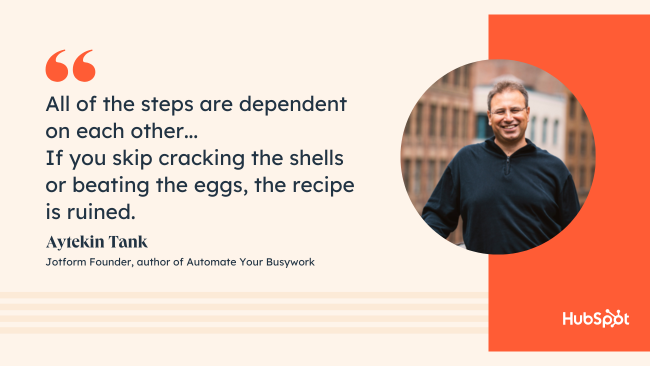Your to-do list is surprisingly misleading. Here’s why.

A colleague and I were recently planning a work trip. For transportation, there were two options: a flight or a train ride. The flight was two hours and the train ride, four. Deciding based on practicality, rather than train nostalgia, most people would choose the airplane.
But then again, there are significantly fewer steps to the train ride. It’s:
— Drive to the train station
— Park
— Board train
— Train ride
— Arrival
The flight, on the other hand, looks something like this:
— Drive to the airport
— Park
— Ride airtrain to terminal
— Check in
— Go through security
— Wait for an hour near the gate
— Board plane
— Flight
— Arrival
In the end, that two-hour flight would have required more time, not to mention, created more stress. My Jotform colleague and I sprung for the train.
At work, many of the items on our to-do list are likewise misleading. A seemingly simple task, like “send an email to Alex,” in fact is a series of discrete steps, or what I call a “workflow.” When we fail to recognize the steps that underlie a task, we end up spending way more time than expected, getting frustrated, and losing motivation to tackle more meaningful work. But when we identify workflows and automate as many steps as possible, we have more time to dedicate to the big stuff.
In my new book, Automate Your Busywork, I write about harnessing the power of workflows. Before we dig into the benefits, let’s take a closer look at the most common types of workflows.
Common workflows and examples
Every workflow has four components: trigger, steps, results, outcome. Many workflows are linear. They unfold in a straight line, like traveling from Point A to Point B. If I’m taking the train from San Francisco to Los Angeles, the train stops in San Jose, Salinas, Paso Robles, San Luis Obispo, Santa Barbara, Oxnard, Simi Valley, and Van Nuys. Once I board the train (the trigger), there are no detours—I know exactly where I’m going and when/where I’ll arrive (the outcome).
Other workflows are non-linear, meaning there are branches and dependencies. If I want to check out the Rosicrucian Museum or Municipal Rose Garden, I’d hop off the train in San Jose. These are the dependencies that will impact the outcome (the nature of the journey and when I arrive).

Some workflows are loops, meaning that the end of the workflow is also the trigger to begin the process all over again. Let’s say you have a weekly email marketing campaign. As soon as you schedule the newsletter for one week, you’re back to the drawing board, drafting the content for the following week.
And finally, there are parallel workflows—multiple steps happening simultaneously. For example, if several teams are collaborating on a product launch, the design team is developing the product’s appearance while the marketing team is hammering out the execution details.
Getting familiar with the various types of workflows will help you to identify and use them to your advantage.
The perks of working with workflows
The “interconnected” aspect of a workflow is important because it captures the fact that all of the steps are dependent on each other—forget one and the whole process is thrown off. Say you’re making scrambled eggs. If you skip cracking the shells or beating the eggs, the recipe is ruined.
Understanding the nature of workflows and breaking them down into steps has multiple benefits.

1. Obviates the need for motivation
When you map out the full process of a task in advance, you’re no longer deciding whether to do something, searching for motivation, or wondering what to do next. When the trigger happens, the workflow sets in motion.
For example, for the longest time, I wanted to commit to exercising before work. But every morning, when my alarm went off, I’d lie in bed wondering if I should go search for my gym clothes or sleep a little longer. And even when I found the motivation to get out of bed, if one obstacle arose—if I forgot to buy coffee or couldn’t find my running shoes—I took it as a sign to try again tomorrow.
One day, I mapped out exercise like a workflow:
- Alarm goes off, wake up.
- Start coffee machine.
- Get dressed in gym clothes.
- Drink coffee.
- Drive to the gym.
- Submit to personal trainer for one hour of torture exercise.
- Shower and dress for work.
- Drive to the office.
- Get a cup of coffee and sit at desk.
I also mapped out the night-before steps, like cleaning my gym clothes and preparing the coffee machine. From that point forward, when my alarm went off, there was no deliberation or second-guessing—I just ran through the workflow and didn’t worry about obstacles.
It’s a simple example, but it demonstrates the logic of the workflow. What’s more, once the workflow is in place, it gets easier with time. Like the Pavlov effect, as soon as the trigger happens, the steps kick off.
2. Exploring your workflows can highlight flaws
Another benefit of mapping out a workflow is that it gives you the chance to see where things tend to go awry.
Say you have a weekly newsletter and aren’t getting as many sign-ups as you had hoped. By taking the time to break down the process into steps, you might realize that you overlooked the sign-up button in the newsletter itself; or you forgot to include the crucial “confirm subscription” step.
Sometimes, it’s important to slow down and examine our processes. But you’ll get back all that time (and more) once your workflow is up and running smoothly.
3. Exploring your workflows can illuminate opportunities for automation
Finally, workflows can help us to spot steps that are candidates for automation.
In my book, I shared an example about a friend. On a typical day, he’d get requests, mostly questions from his team, via all platforms: email, texts, instant messages, and occasionally, a phone call. After 15 years in the business, many of the questions involved patterns that my friend had seen again and again. So I was surprised to learn that my friend didn’t have a single template for any of his answers.
With some time and effort, my friend examined the relevant workflows and created those templates. Then, he was able to eliminate the need to provide thoughtful responses to hundreds of these questions, ultimately shaving a ton of time off his daily busywork.There are quite a few workflow automation tools out there. Some that stand out are Zapier and its ability to connect countless apps, HubSpot’s marketing automation software, and Jotform’s powerful forms to decrease busywork.
Final thoughts
We often fail to understand the structure of our workflows, and why isolated tasks end up taking more time than we estimate; why the plane seems like a smart idea but ultimately leaves us tired and frazzled at the destination.
Understanding workflows can help you create reasonable time expectations for your daily journey. It can also enable you to identify which steps can be fixed or automated.
The goal of all this is to enable you to spend less time on busywork and more time on more meaningful activities—the stuff that leaves you feeling engaged and inspired. And once your workflows are in place and you’re able to focus more on that big stuff, it’s a self-propelling wheel. Your work feels more meaningful and you’re inspired to keep creating workflows and automating as much as possible.

